Explainability in AI: Enhancing Trust and Transparency in ML/DL Models
Table of Contents
- Introduction
- Understanding AI Explainability
- Trust and Transparency: Key Elements in AI
- Methods for AI Explainability
- Navigating the Challenges of Explainable Deep Learning
- The Importance of Rules and Standards in Making AI Understandable
- Real-World Success Stories of Clear AI
- The Future of Clear and Understandable AI
Introduction
Understanding AI: Today, Artificial Intelligence (AI), especially in areas like Machine Learning (ML) and Deep Learning (DL), is becoming a key part of technology development. These advanced technologies are everywhere, from healthcare and finance to self-driving cars and customer service. It’s crucial that we trust these technologies and understand how they work.
AI’s decision-making can sometimes be a mystery, often called the “black box” problem. As AI gets more complicated, it becomes harder to understand its decision-making process. This is a big deal because AI’s choices can greatly affect our lives. It’s important not only to know how AI reaches its decisions but also to make sure these decisions are fair and ethical. This builds confidence in AI and makes sure it helps society move forward.
There’s also a legal side to this. Laws like the European Union’s General Data Protection Regulation (GDPR) are now asking for AI to be explainable. People should be able to understand and question AI decisions that impact them.
Yet, making AI understandable, especially in ML and DL, is challenging. These systems are complex, driven by intricate designs and large amounts of data, making it tough to pinpoint how decisions are made. This article aims to make the complex world of AI clearer and show ways to make these systems more open and reliable.
In the next parts, we’ll dive into the details of AI explainability, look at methods and tools to achieve it, and see real-world examples where making AI more understandable has improved trust and transparency.
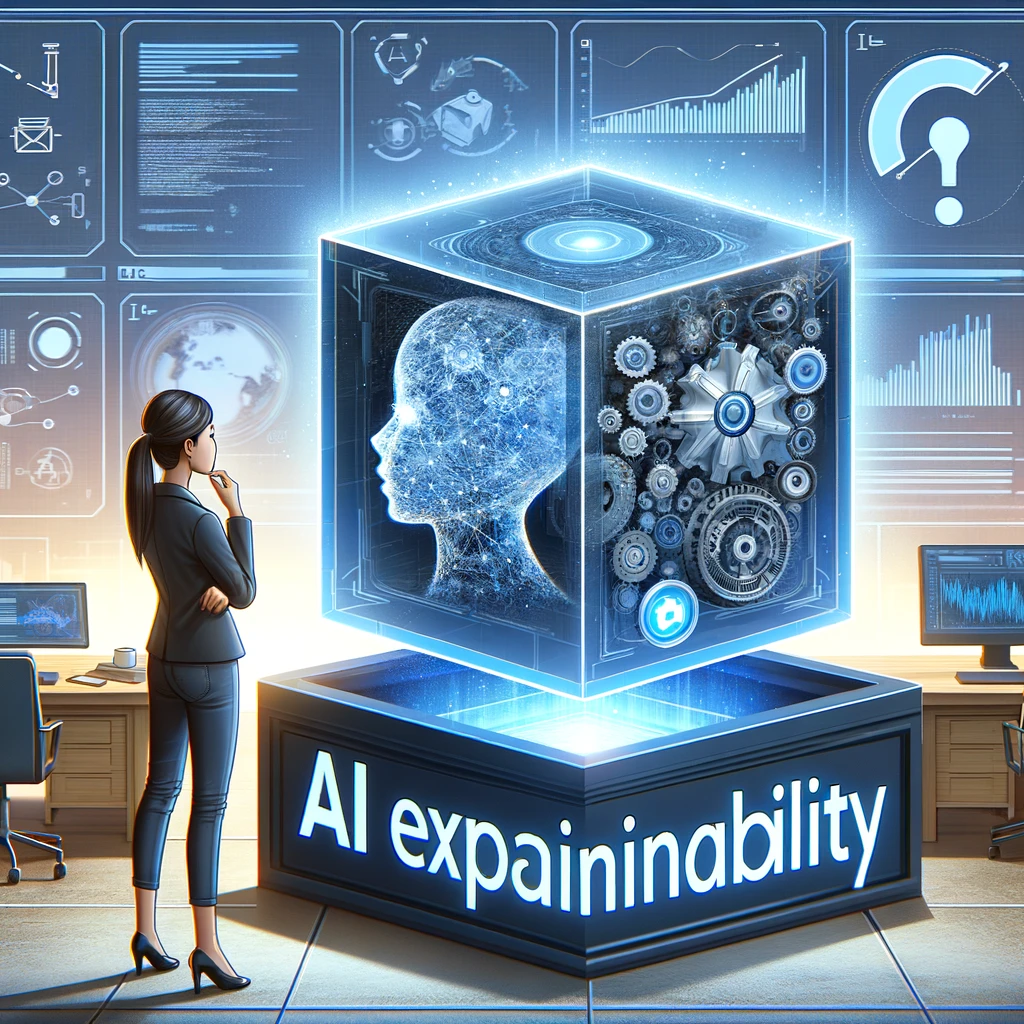
Understanding AI Explainability
Let’s go deeper into the world of AI and see what makes AI “explainable” and how it differs from “interpretable.” Though often used interchangeably, these terms have unique meanings in AI.
- Interpretability means how well a person can understand why an AI system made a certain decision. It’s about grasping the thought process of the AI model.
- Explainability goes a step further. It’s not just about understanding the decision, but also being able to put the reason behind the decision into words that people can understand. It’s like the story that comes with an AI’s decision.
The Basics of ML/DL in AI
Before getting into explainability, let’s understand the technologies behind it:
- Machine Learning (ML): A part of AI, ML uses algorithms to analyze data, learn from it, and then make decisions or predictions.
- Deep Learning (DL): A more complex part of ML, DL uses structures called neural networks to examine various elements in large data sets. These networks, similar to the human brain, add to the complexity of AI models.
Why Explainability Is Important
Explaining AI isn’t just about technology; it’s about connecting advanced systems with their human users. Here’s why it matters:
- Building Trust: For AI to be really useful in sensitive areas like healthcare or finance, people need to trust its decisions. Explaining how AI works builds this trust.
- Fairness and Ethics: Sometimes, AI might unintentionally reflect biases from the data it was trained on. By making AI explainable, we can identify and reduce these biases.
- Legal Needs: With laws requiring more openness in automated decision-making, making AI explainable is becoming a legal need.
- Better Collaboration: Explainable AI lets people from different fields work together more effectively by providing a common understanding.
The Challenge of AI Explainability
Making AI explainable is tough, especially with complex Deep Learning models. As these models grow more advanced, it gets harder to track how they make decisions. This complexity is a two-sided issue – while it lets AI handle complex tasks, it also makes explaining decisions more difficult.
In the next sections, we’ll explore various ways to tackle this challenge, aiming to make AI not only more powerful but also more understandable and transparent. This move towards explainable AI is about improving AI and making it more aligned with human needs and ethical standards.
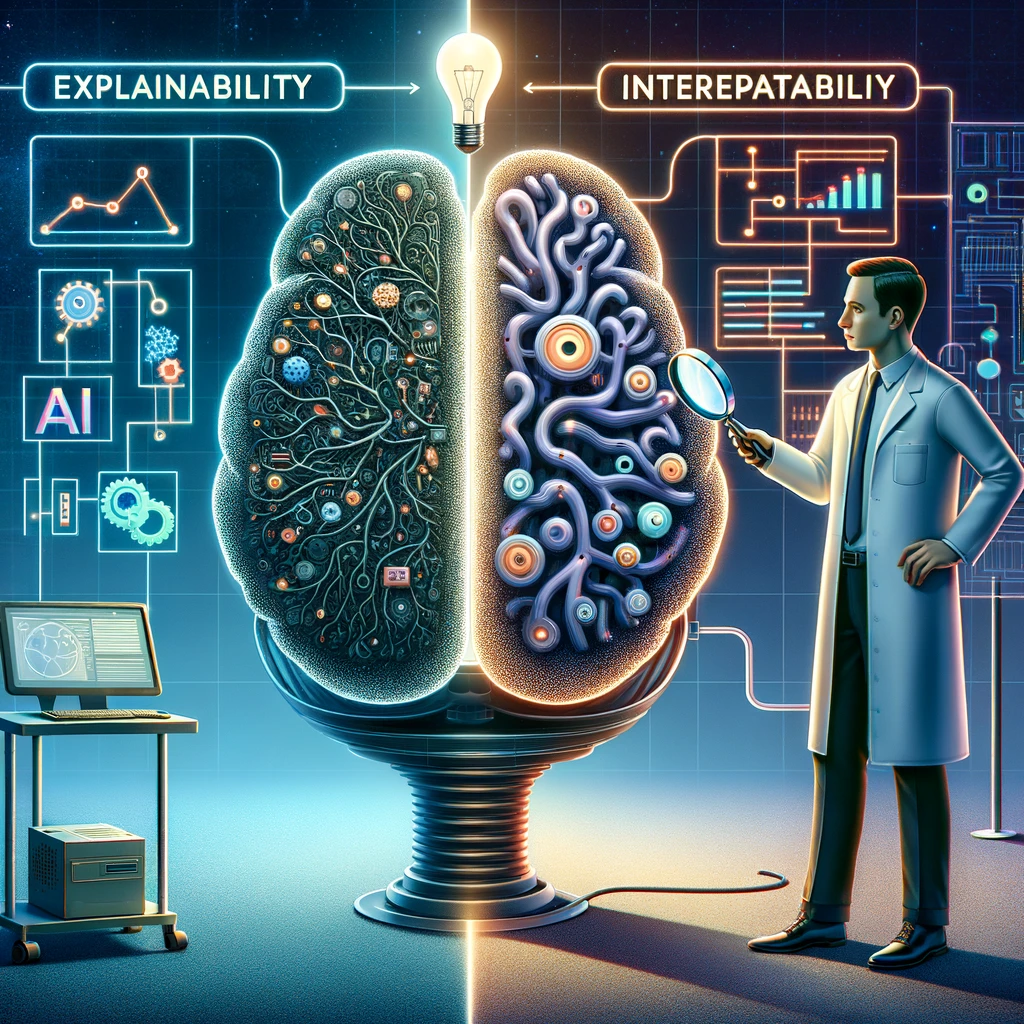
Trust and Transparency: Key Elements in AI
This part of our discussion on AI explainability highlights the vital roles of trust and transparency. These aren’t just extra features; they’re essential for using AI technologies ethically and responsibly.
Ethical Concerns in AI Systems
AI’s ethical implications are vast. If not designed and monitored correctly, AI systems may exhibit biases, make unfair decisions, or invade privacy. These concerns are especially significant in critical areas like healthcare, law enforcement, and employment.
The Trust Gap in AI
A major hurdle in AI’s wider acceptance is the “trust gap.” This gap exists when users or those impacted by AI decisions don’t fully understand or trust how the AI systems reach their conclusions. This gap can lead to reluctance in embracing AI technologies, even if they are beneficial.
Real-World Examples: The Impact of Non-Transparent AI
To understand the importance of transparency and trust, let’s look at some real-life examples:
- In Healthcare: Imagine an AI system that helps diagnose diseases. If this system isn’t transparent and its decisions are unclear, it could lead to distrust among doctors and patients, potentially causing serious health consequences.
- In Finance: In the banking sector, AI might be used to determine creditworthiness. If an AI system denies loans without clear reasons, it can create perceptions of unfairness and legal issues.
- In the Legal System: AI used for predictive policing or sentencing might reinforce existing biases if not transparent, raising significant ethical and justice concerns.
Bridging the Trust Gap
To close this gap, it’s crucial to develop AI systems that are not just technically sound but also transparent and explainable. This involves a few key steps:
- Creating Understandable AI Models: Developing methods and tools that make the reasoning behind AI decisions clearer.
- Educating Stakeholders: Teaching everyone involved, from developers to users and those affected by AI decisions, about how AI functions.
- Regulatory Guidelines: Following and shaping regulations that require transparency and explainability in AI.
In summary, trust and transparency are fundamental for the ethical use and wider acceptance of AI technologies. As AI evolves, it’s essential that these technologies are developed with a focus on explainability, not only for compliance and practicality but for the overall benefit of society.
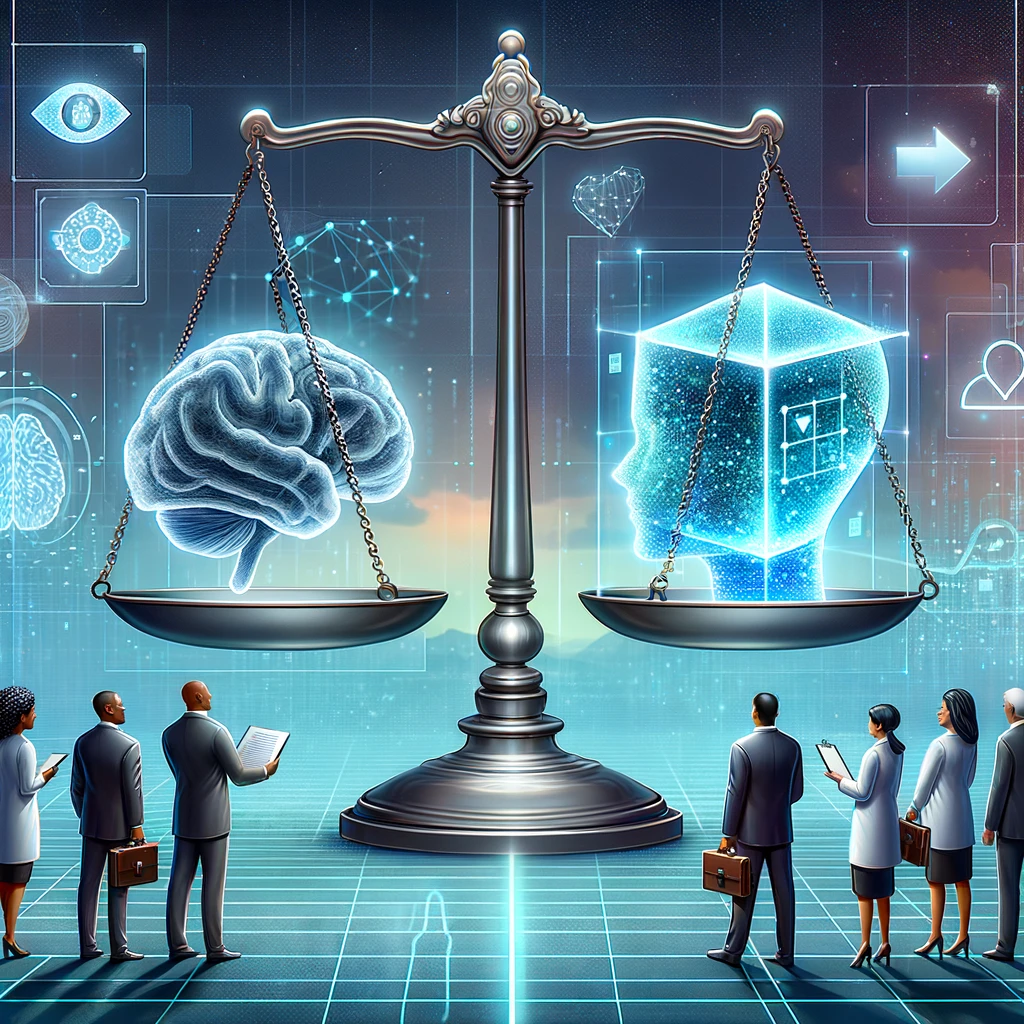
Methods for AI Explainability
In the fourth chapter, we delve into the various methods and techniques developed to enhance the explainability of AI systems. These methods are crucial in making the decision-making processes of AI models more transparent and understandable to humans.
Popular Techniques for Explainable AI
- Local Interpretable Model-agnostic Explanations (LIME): LIME helps in understanding complex models by approximating them locally with an interpretable model. It works by perturbing the input data and observing the changes in outputs, thereby gaining insights into the model’s behavior.
- SHapley Additive exPlanations (SHAP): SHAP leverages game theory to explain the output of any machine learning model. It assigns each feature an importance value for a particular prediction, helping to understand the model’s decision-making process in a more granular way.
- Counterfactual Explanations: This method involves changing the input data slightly until the model’s decision changes, providing insights into what could have been different for an alternative decision to be made. It’s a way of answering “what-if” questions.
Practical Code Example:
1. LIME Example
Context: A basic text classification model to classify text as ‘spam’ or ‘not spam’.
Code:
First, install LIME:
!pip install limeNow, let’s create a simple text classifier and apply LIME:
import lime
import sklearn
import numpy as np
from sklearn.feature_extraction.text import TfidfVectorizer
from sklearn.naive_bayes import MultinomialNB
from sklearn.pipeline import make_pipeline
from lime.lime_text import LimeTextExplainer
# Sample data
texts = ["Free money now!!!", "Hi Bob, how about a game of golf tomorrow?", "Limited time offer"]
labels = [1, 0, 1] # 1 for spam, 0 for not spam
# Create a vectorizer and classifier pipeline
vectorizer = TfidfVectorizer()
clf = MultinomialNB()
model = make_pipeline(vectorizer, clf)
# Train the model
model.fit(texts, labels)
# Create a LIME explainer
explainer = LimeTextExplainer(class_names=["not spam", "spam"])
# Choose a text instance to explain
idx = 0
exp = explainer.explain_instance(texts[idx], model.predict_proba, num_features=2)
# Show the explanation
exp.show_in_notebook(text=True)
2. SHAP Example
Context: A simple model predicting house prices.
Code:
First, install SHAP:
!pip install shap
Now, let’s apply SHAP to a regression model:
import shap
import pandas as pd
from sklearn.model_selection import train_test_split
from sklearn.ensemble import RandomForestRegressor
# Sample data
data = pd.DataFrame({
'size': [2104, 1416, 1534, 852],
'bedrooms': [5, 3, 3, 2],
'price': [460, 232, 315, 178]
})
X = data[['size', 'bedrooms']]
y = data['price']
# Split data
X_train, X_test, y_train, y_test = train_test_split(X, y, test_size=0.2, random_state=0)
# Train a model
model = RandomForestRegressor(random_state=0)
model.fit(X_train, y_train)
# SHAP explainer
explainer = shap.TreeExplainer(model)
shap_values = explainer.shap_values(X_test)
# Visualize the first prediction's explanation
shap.initjs()
shap.force_plot(explainer.expected_value, shap_values[0], X_test.iloc[0])3. Counterfactual Explanations Example
Context: A simple binary classification model (e.g., loan approval).
Code:
We’ll use the alibi library for counterfactual explanations:
!pip install alibiNow, let’s create an example:
import alibi
import numpy as np
from sklearn.datasets import load_iris
from sklearn.ensemble import RandomForestClassifier
from alibi.explainers import CounterFactual
# Load a sample dataset
data = load_iris()
X = data.data
y = (data.target == 0).astype(int) # Binary classification
# Train a model
model = RandomForestClassifier()
model.fit(X, y)
# Instance to explain
instance = X[0].reshape(1, -1)
# Counterfactual explainer
cf = CounterFactual(model.predict, shape=instance.shape)
# Generate counterfactual
explanation = cf.explain(instance)
# Show the counterfactual
print("Original instance:", instance)
print("Counterfactual instance:", explanation.cf['X'])
print("Counterfactual prediction:", model.predict(explanation.cf['X']))Please note that these are simplified examples for illustration. In real-world scenarios, you would work with more complex models and larger datasets. Each method requires a good understanding of the model’s structure and the data it’s trained on to be effectively applied.
Visualizing and Interpreting the Results
The final step is visualizing the explanations provided by LIME. This usually involves graphical representations, like bar charts, showing the weight of each feature in the decision-making process. These visualizations are key in making the explanations accessible and understandable to non-technical stakeholders.
In summary, methods like LIME, SHAP, and Counterfactual Explanations are essential tools in the quest for explainable AI. By shedding light on the decision-making processes of AI models, they not only enhance transparency but also build trust and confidence in AI systems.

Navigating the Challenges of Explainable Deep Learning
In this section, we explore the unique challenges of making Deep Learning (DL) models understandable, a key part of AI explainability.
The Intricacy of Deep Learning Models
Deep Learning models are complex. They’re like intricate webs of connections, mimicking the human brain. This complexity lets them handle diverse and complicated tasks but also makes it tough to understand how they reach conclusions.
Why Deep Learning Is Hard to Explain
- The ‘Black Box’ Issue: Many Deep Learning models are like ‘black boxes’ – we see their inputs and outputs, but what happens inside is hard to decipher. This is particularly true for models with a vast number of parameters.
- Data-Driven Decisions: These models heavily rely on the data they’re trained on. When the data is complex, like images or text, it becomes even harder to understand why the model made a certain decision.
Practical Code Example: Using SHAP in a DL Context
To illustrate the use of explainability methods in DL, let’s consider using SHAP (SHapley Additive exPlanations) with a Deep Learning model.
Scenario
A CNN model trained on a simple image dataset, like the Fashion MNIST dataset, which includes various clothing items. Our goal is to use SHAP to understand which parts of the image most influence the model’s classification decision.
Code Walkthrough
First, let’s set up the environment and the dataset:
!pip install tensorflow shap
import tensorflow as tf
import numpy as np
import shap
import matplotlib.pyplot as plt
# Load Fashion MNIST dataset
fashion_mnist = tf.keras.datasets.fashion_mnist
(train_images, train_labels), (test_images, test_labels) = fashion_mnist.load_data()
# Normalize the images
train_images = train_images / 255.0
test_images = test_images / 255.0
# Reshape images for the CNN
train_images = train_images.reshape(-1, 28, 28, 1)
test_images = test_images.reshape(-1, 28, 28, 1)Next, we define and train a simple CNN model:
# Define the CNN model
model = tf.keras.Sequential([
tf.keras.layers.Conv2D(32, (3, 3), activation='relu', input_shape=(28, 28, 1)),
tf.keras.layers.MaxPooling2D((2, 2)),
tf.keras.layers.Flatten(),
tf.keras.layers.Dense(128, activation='relu'),
tf.keras.layers.Dense(10)
])
# Compile the model
model.compile(optimizer='adam',
loss=tf.keras.losses.SparseCategoricalCrossentropy(from_logits=True),
metrics=['accuracy'])
# Train the model
model.fit(train_images, train_labels, epochs=5)Finally, we apply SHAP to explain an individual prediction:
# Select a subset of the test data for the SHAP explainer
background = test_images[np.random.choice(test_images.shape[0], 100, replace=False)]
# Create a SHAP explainer
explainer = shap.DeepExplainer(model, background)
# Choose a test image to explain
test_image = test_images[0]
shap_values = explainer.shap_values(test_image.reshape(1, 28, 28, 1))
# Plot the SHAP values
shap.image_plot(shap_values, -test_image.reshape(1, 28, 28, 1))This code will display a plot indicating which pixels in the chosen test image were most influential in the model’s prediction. It provides a visual insight into the inner workings of the CNN, highlighting the challenge of interpreting complex deep learning models.
Remember, this example is quite basic and meant for illustration purposes. In real-world scenarios, the models, datasets, and interpretability techniques can be far more complex.
Looking Forward
Despite these challenges, there’s ongoing research and development aimed at making Deep Learning models more understandable. This work is crucial for ensuring that as AI advances, it aligns with our values and ethical standards. The next chapter will delve into the role of regulation and standardization in promoting better explainability in AI.

The Importance of Rules and Standards in Making AI Understandable
In this section, we discuss how laws and standardization play a crucial role in making AI systems more transparent and explainable.
The World of AI Regulations
- General Data Protection Regulation (GDPR): This is a significant law from the European Union. It includes rules about automated decision-making and requires that people have a right to understand decisions made by AI, pushing for more open AI systems.
- Different Approaches Worldwide: Various countries are creating their own rules about AI, focusing on ethical AI use, responsible deployment, and managing AI systems.
Efforts to Standardize AI
Standardizing AI involves setting global standards, particularly regarding ethics and transparency. This includes:
- ISO Standards: The International Organization for Standardization (ISO) is working on AI standards, focusing on safety, transparency, and ethical considerations.
- Industry-Led Initiatives: Many companies are also developing their own standards for explainable AI, often in response to existing or expected regulations.
Balancing Innovation and Regulation
A key challenge here is finding the right balance. Too much regulation might slow down AI innovation, but too little could lead to ethical and transparency issues. It’s important to encourage innovation but within a framework that ensures AI is developed ethically and transparently.
What the Future Holds
As AI continues to evolve, we can expect more detailed and specific regulations and standards aimed at ensuring AI systems are not only effective but also fair, ethical, and transparent.
In conclusion, laws and standardization are crucial for the development of understandable AI systems. They guide ethical AI development, ensuring that these technologies are used responsibly and for the benefit of everyone.
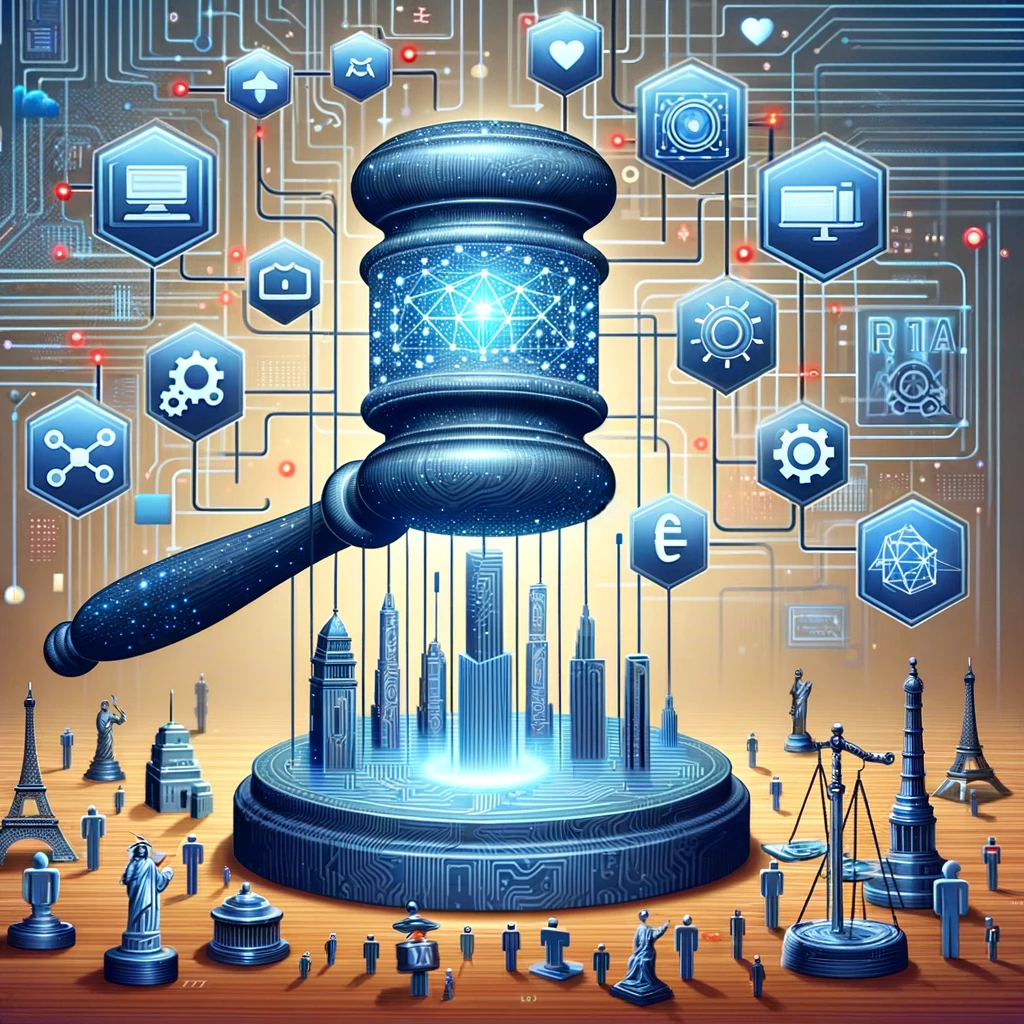
Real-World Success Stories of Clear AI
This part of our article looks at how making AI more transparent and understandable has been beneficial in various fields.
Healthcare: Better Diagnosis with AI
Case Study: Using AI to Diagnose Diseases
- Background: A tech company in healthcare developed an AI system to help diagnose diseases from medical images.
- Challenge: Doctors were hesitant to trust the AI because they didn’t understand how it made its decisions.
- Solution: The company added tools to the AI that explained its reasoning in a way that doctors could understand.
- Result: Doctors began to trust and understand the AI’s advice, leading to better diagnoses and patient care.
Finance: Fairer Credit Decisions
Case Study: AI in Assessing Credit Scores
- Background: A financial technology company used AI to determine credit scores.
- Challenge: Customers were often confused and unhappy with their scores, not understanding how they were calculated.
- Solution: By implementing ways to explain credit decisions, the company could give customers clear reasons for their scores.
- Result: This openness improved customer satisfaction and helped the company to find and fix biases in their AI model.
Legal System: Fairness in Sentencing
Case Study: AI Assisting Judges
- Background: An AI system was designed to help judges with sentencing.
- Challenge: There were worries about bias and fairness due to the AI’s opaque nature.
- Solution: Introducing explainable AI techniques provided insights into the AI’s recommendations, ensuring they were fair.
- Result: This led to more confidence in the judicial process from both judges and the public.
These examples highlight the importance of making AI understandable in various sectors. By clarifying AI decisions, these systems become trusted tools in decision-making processes.
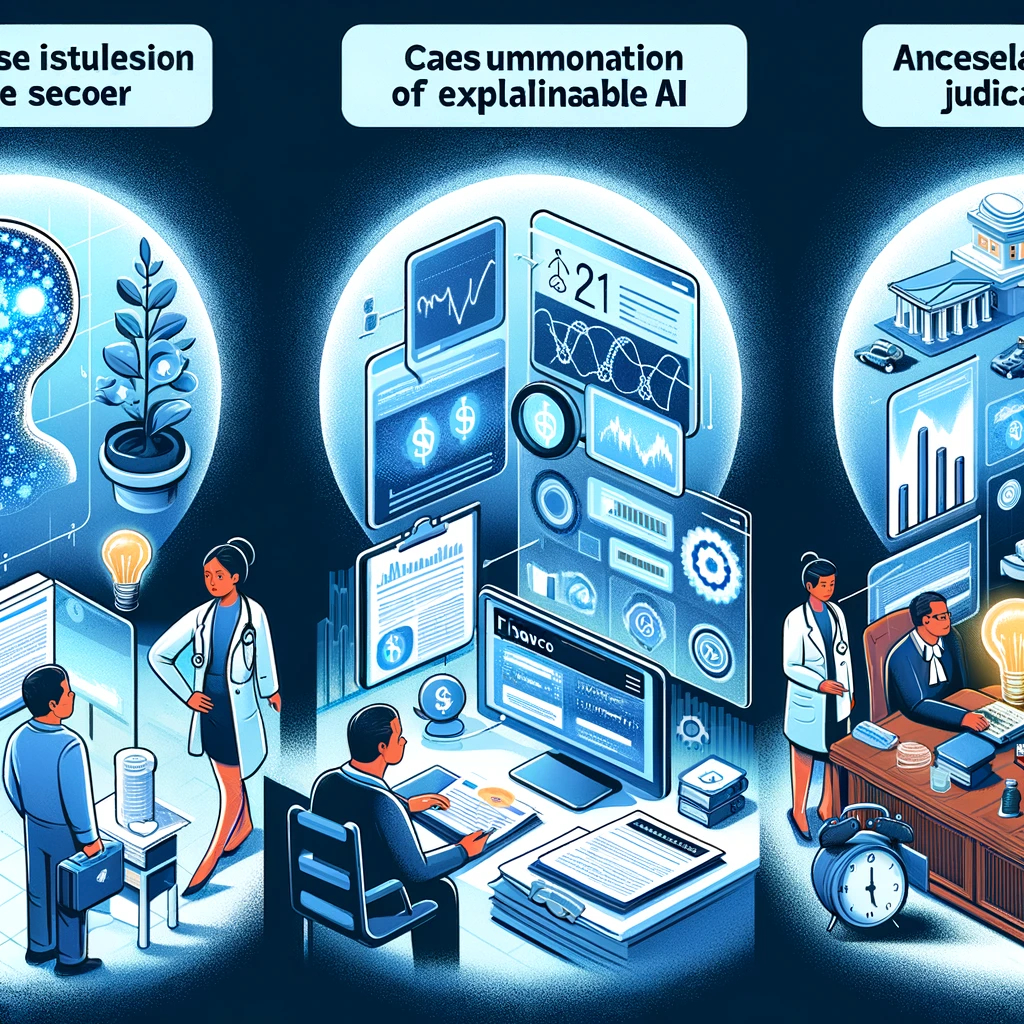
The Future of Clear and Understandable AI
Looking ahead, the field of AI explainability is set to change significantly. The way AI technologies are advancing, combined with the growing need for them to be clear and ethical, will shape how we interact with and comprehend AI.
Trends and Predictions
- More Advanced Ways to Explain AI: As AI models get more complex, the methods to explain them will also improve, becoming better equipped to handle this complexity.
- Incorporating Explainability from the Start: We’ll see a shift towards including explainability as a fundamental part of AI development, not just an add-on.
- Influence of Regulations: Increasing rules and standards will drive research and innovation in making AI more understandable, leading to new best practices.
- Making AI Explainability User-Friendly: Tools to understand AI will become easier to use, allowing even those without expert knowledge to grasp AI decisions.
- Focus on Ethical AI: There will be a stronger emphasis on creating AI that is not only technically sound but also ethically responsible and aligned with human values.
The future of AI explainability isn’t just about technology; it’s about creating AI systems that are ethical, transparent, and fair, enhancing human decision-making and societal well-being.
Conclusion
In wrapping up our exploration of AI explainability, it’s clear how vital it is in AI development and use. From healthcare to finance, from legal systems to daily applications, transparent, understandable, and fair AI is essential.
The challenges in making complex models like those in deep learning understandable are significant, but they can be overcome with the right tools, techniques, and regulatory support. AI, as it becomes more a part of our lives, should advance in a way that aligns with our values and ethical standards. Pursuing explainability in AI is not just a technical goal; it’s a commitment to a future where technology enhances our lives in ways that are clear and understandable.









